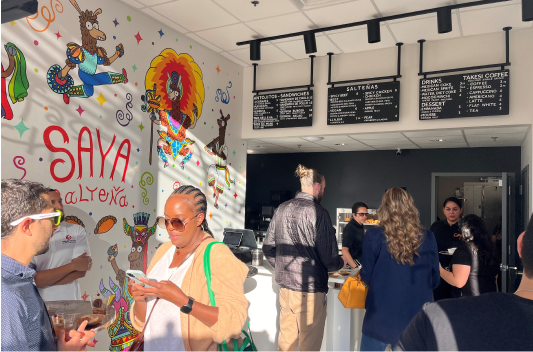
Foundational Elements
Five Foundational Elements reflect improvements the District must make to strengthen the entirety of Downtown D.C. and to create a more stable and fertile platform for success of the place-specific interventions described in the nodes.
In the following Foundational Elements & Nodes sections, items labeled as:
“Now” | FY 2025 budget priorities
“Near Term” | FY 2026 & FY 2027 budget priorities
“Future” | future priorities, once initial investments have been made
Anchoring Downtown’s Comeback in Public Safety
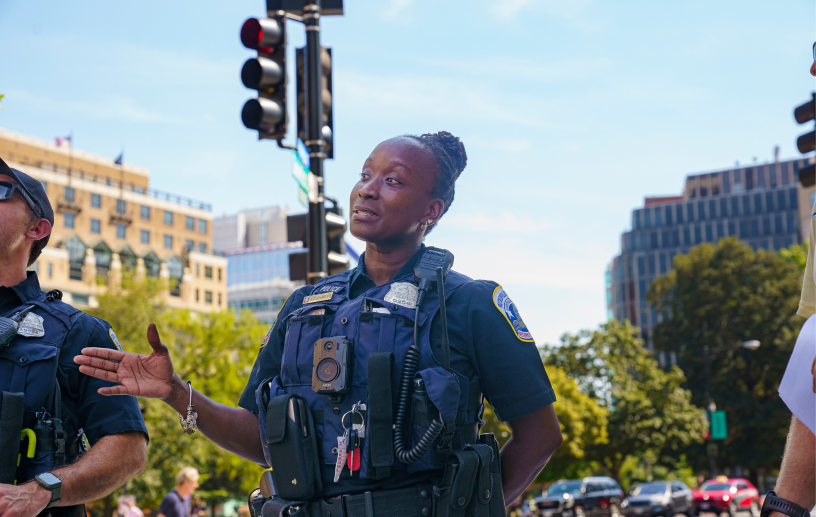
Proactively and aggressively address safety concerns, developing both top-down and bottom-up approaches to public safety.
Building upon the extensive efforts the District is already taking to combat these challenges, a multi-pronged approach to public safety in Downtown D.C. can help provide a secure foundation on which other interventions can build.
Now
- Expand budgeted resources for the Safe Commercial Corridor Grant Program
- Enhance public safety deployment strategies and improve incident response times by considering Police Service Area boundaries, identifying a Downtown police substation, and/or creating additional Safe Commercial Corridor Hubs.
- Continue to support a real-time crime center (RTCC)
- Continue to support the Multiagency Nightlife Task Force, and consider the inclusion of new resources to alleviate pressure on Metropolitan Police Department (MPD) resources
- Draft and implement comprehensive legislation specifically targeting organized retail theft
- Address pinch points in the permanent supportive housing case management system
- Conduct a lighting assessment and incorporate additional lighting as necessary
Near Term
- Establish two Neighborhood Safety Centers—one in the eastern portion of Downtown D.C. and one in the western portion to ensure resources are allocated efficiently—where police, fire, mental health, and other first responders can co-locate within Downtown D.C.
- Expand MPD’s Housing Assistance program to incentivize long-term relocation of public employees to Downtown D.C.
Future
- Enhance the visibility and presence of foot- and bike-based officers in Downtown D.C.
- Fund grants for business improvement districts to operate safety ambassador programs
- Develop a mental health first responder program, pairing mental health professionals with emergency medical technicians
Creating a Place of Choice to Locate & Do Business
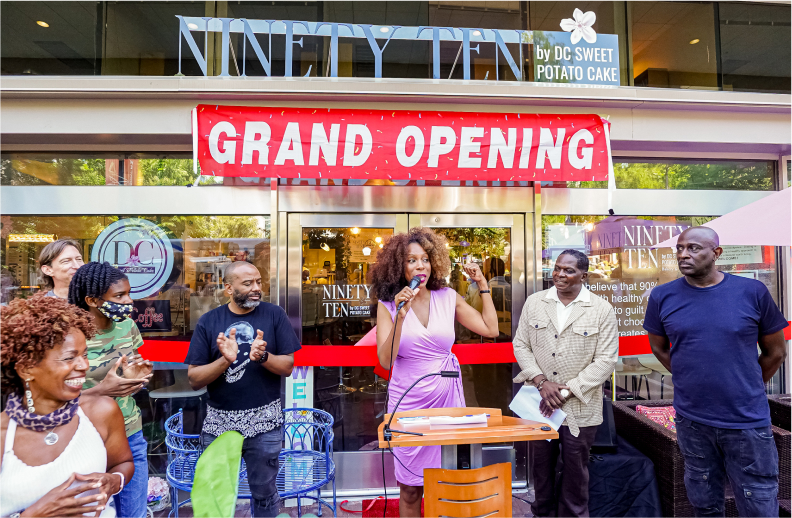
Enhance the attractiveness of Downtown D.C. as a place to start and grow businesses, and expand the toolkit with which the District can attract these businesses and enable them to thrive.
Today, the District features a stringent regulatory environment that impacts businesses of all sizes in Downtown D.C. By lowering barriers for existing and future businesses, the District can support long-term talent retention and cultivate increased entrepreneurial spirit, creating economic windfalls in the process.
Now
- Streamline and simplify regulations, especially those that disproportionately impact small businesses, in the areas of licensing, permitting, and documentation (e.g., Clean Hands)
- Increase staff capacity for business attraction and retention, and align attraction and incentive efforts around target industry clusters as identified in the Comeback Plan
- Develop marketing plans to attract firms in target industry clusters, as well as real estate firms and investors with specialty areas related to Downtown Action Plan interventions
- Launch a soft landing program to attract international companies
- Create a new grant program for pop-up and short-term retail in high vacancy areas, and expand the Retail Recovery grant program to support long-term businesses
- Explore updates to street vending license requirements to dissuade organized shoplifting
- Improve interagency coordination around special event proposals to streamline review and dedicate funding for recurrent events and activations that require road closure and security
Near Term
- Expand the Vitality Fund and improve its structure, through such changes as loosening eligibility requirements to support a broader base of users
- Expand incentives for early-stage firms to include seed grants and other investments
Future
- Create a Downtown Business Resource Center to accelerate delivery of licenses and permits for small and medium-size businesses that have decided to invest in Downtown D.C.
- Create a dedicated technology entity to invest in early-stage companies and entrepreneurs
- Establish a regulatory free trade zone to attract firms in target industry clusters
- Offer tax abatements for target retail tenants that help to satisfy broader programming goals along commercial corridors
Building a Residential Base
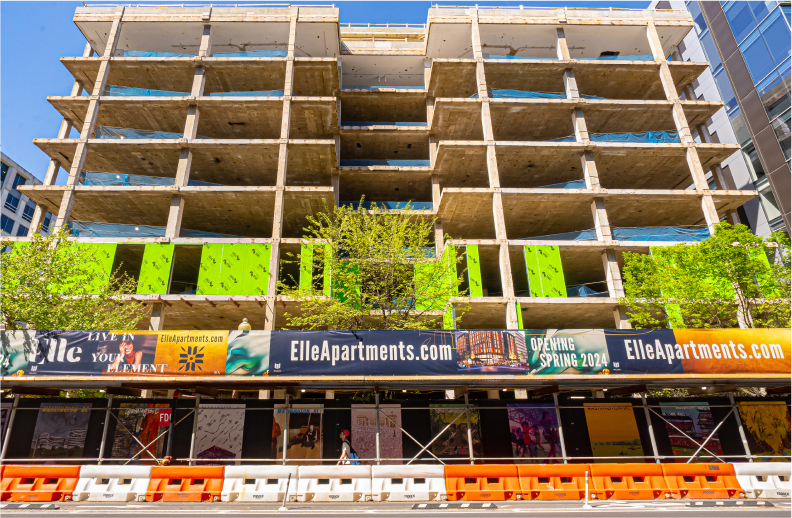
Improve the ability for housing conversions and new developments to occur in Downtown D.C., and create appealing residential nodes that make the area more inclusive, multigenerational, and equitable.
With fewer than five housing units for every 100 employees, Downtown D.C. features an employment-centric built environment, and a lack of housing opportunities places it at a growing competitive disadvantage. Realizing strong demand for housing in Downtown D.C. will require the District to adopt a more aggressive and concerted residential strategy to position the submarket as a desirable place to live, work, and play.
Now
- Implement the Housing in Downtown Tax Abatement program, monitoring uptake to explore opportunities for expansion, such as introducing geographic bonuses in key nodes
- Install and implement streamlined construction and building permit processes—providing velocity permitting at no cost to residential projects—and clarify building fee structure
- Increase feasibility of conversions and redevelopment by introducing flexibility in building codes and BEPS program standards, grandfathering in curb cuts, and automatically adjusting tax classifications of new multifamily developments
- Begin effort to amend the Height Act by studying areas where modest increases in height caps could maximize affordable housing opportunities
- Improve efficiency and clarity of the condominium warranty claims process
- Define goals for household services and social infrastructure (e.g., grocery stores, recreation centers, daycare, senior services, parks, etc.), and establish a grant program to encourage the creation of residential amenities necessary to support a growing household base
- Address regulatory and zoning issues that currently prevent fabrication, food prep, live-work, and other residential-serving facilities and uses
- Update streetscape guidelines to support retail and social infrastructure uses
Near Term
- Establish two Neighborhood Safety Centers—one in the eastern portion of Downtown D.C. and one in the western portion to ensure resources are allocated efficiently—where police, fire, mental health, and other first responders can co-locate within Downtown D.C.
- Expand MPD’s Housing Assistance program to incentivize long-term relocation of public employees to Downtown D.C.
Future
- Enhance the visibility and presence of foot- and bike-based officers in Downtown D.C.
- Fund grants for business improvement districts to operate safety ambassador programs
- Develop a mental health first responder program, pairing mental health professionals with emergency medical technicians
Planning for Transportation as an Asset

Build on the District’s competitive advantage of having an accessible, multimodal, and pedestrian-first central business district, and improve the ease with which all users can travel to, from, and within it.
Although Downtown D.C. contains robust transportation infrastructure, the area lacks a system-wide approach to ensure each travel mode is allocated sufficient dedicated space on public rights of way. A substantial number of commuters travel into Downtown D.C. on foot, by bike, and via public transit, highlighting the strong opportunity to lean into this core competitive strength. At the same time, the District must accommodate commuter and visitor demand for automobile trips and parking in ways that improve the efficiency of everyone’s access to Downtown D.C.
Now
- Advocate for responsible, sustainable, and dedicated funding of Metro in partnership with other jurisdictional partners
- Create a long-term transportation plan for Downtown D.C. that delineates modal hierarchies of streets, while continuing to advance new measures of evaluation to give appropriate weight to all transportation modes
Near Term
- Implement a dynamic pricing program for on-street parking
- Create a common platform for off-street parking management to improve utilization of off-street garages
- Expand sidewalks to include uses that promote retail, culture, and recreation (e.g., café seating, parklets, etc.) in targeted areas where such spaces can boost foot traffic
Future
- Prioritize completion of existing Vision Zero projects identified on the high-injury network
- Consider planning for the removal of legacy one-way street configurations
- Implement special design corridors and streets, integrating multi-modal mobility systems along key corridors such as K Street, 8th Street, 17th Street, New Jersey Avenue, 19th Street, and F Street
- Work with jurisdictional partners to secure funding for interior and exterior modernization of Downtown D.C. Metrorail stations, including greater resources for visitors
- Expand tree canopy and building-to-building fabric shade elements, especially in areas targeted for increased pedestrian use; I Street represents a particularly strong location for such investments, given the Lush Greenway plan in the Public Realm Plan
- Rebalance and expand Capital Bikeshare capacity and expand existing e-bike rebates to encourage non-motorized travel
- Establish dedicated pedestrian zones, building on ongoing District experimentation (e.g., 18th Street in Adams Morgan) and examples from other major downtowns; candidates for these efforts include F Street and G Street, where the Public Realm Plan envisions a year-round market
Making it Happen
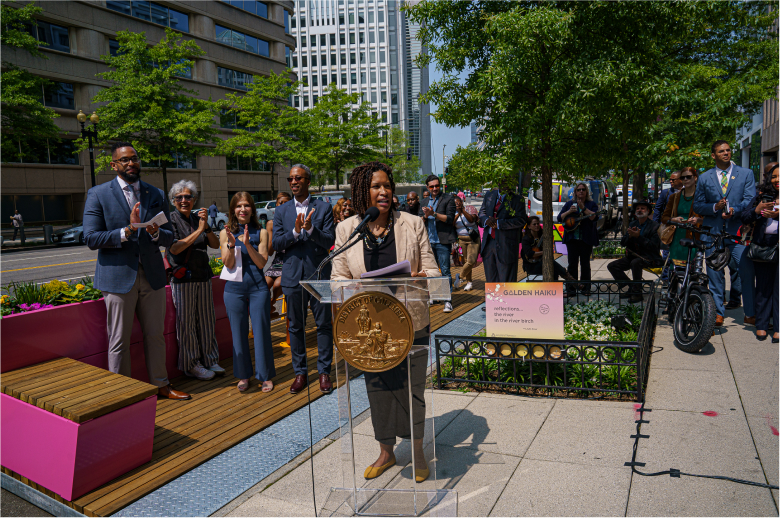
Lay the groundwork for the successful execution of the Downtown Action Plan, and develop a strategy for distressed and public assets.
Meeting the ambitious goals laid out in the Downtown Action Plan will require continued forward momentum. To that end, the District should convene a Downtown Action Plan Committee, consisting of key agency heads, BID leadership, and private sector stakeholders. Over time, this group should evaluate whether additional implementation support is needed from another, separate entity to accelerate the repositioning of distressed office buildings or to execute redevelopment plans for key opportunity sites.
Now
- Convene an interdisciplinary Downtown Action Plan Committee of key agency heads, BID leadership, and private sector stakeholders, including subcommittees dedicated to the foundational elements, key nodes, and other focus areas. The Downtown Action Plan Committee should meet no less than quarterly to track implementation
- Create a smaller Downtown Action Plan Implementation Team consisting of representatives from DMPED and the BIDs that should meet no less than monthly to coordinate on actions and strategies in support of the Downtown Action Plan Committee
- Utilize funding levels and schedule priorities from the Downtown Action Plan to create a multi-year implementation plan and budget
- Increase in-house capacity by (1) identifying an individual or team within District government to serve as strategic ombudsman for Downtown D.C., and by (2) creating a dedicated university relations liaison to act as point person for universities operating in Downtown D.C.
- Provide development grants to help the market repurpose obsolete office buildings and pursue catalytic development projects. Based on progress, consider whether an additional entity would be additive to Downtown Action Plan Implementation Team efforts to execute on plans for opportunity sites
Near Term
- Ensure other potential opportunity sites are planned, targeted, and marketed to maximize their impact on Downtown and to align with broader programming goals
Learn More
Download the Downtown Action Plan for more details.